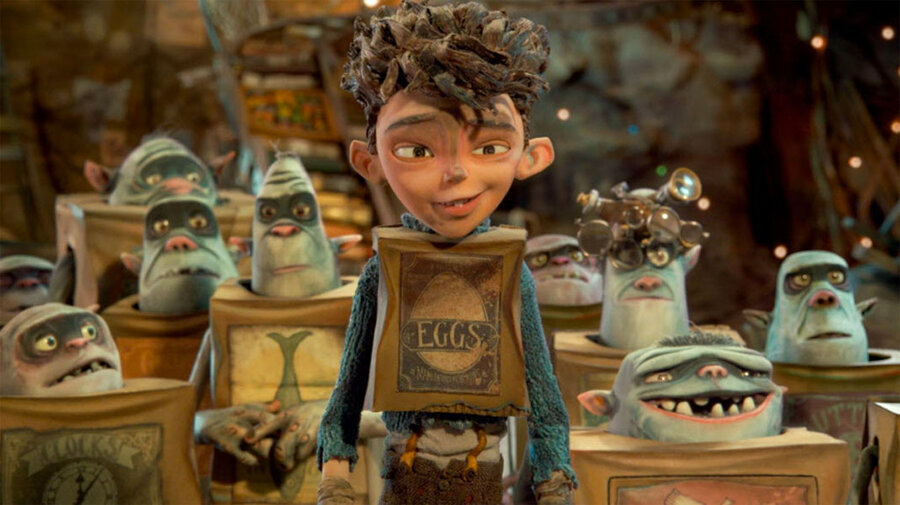‘The Boxtrolls’: Puppets, sets mean the movie’s world is real enough to touch
Loading...
Archibald Snatcher, "The Boxtrolls" villain voiced by Ben Kingsley, did not walk between sets during filming. Instead, he was delicately perched on a pillow and wheeled gingerly through the studio.
This wasn't a Hollywood diva demand that required Snatcher to be treated like precious cargo. As an 18-inch-tall, hand-made puppet actor, he actually IS precious cargo: the result of countless hours of conceptualization and craft; a work of art with a jointed metal skeleton, silicone skin and hair made from hemp.
If the world of "The Boxtrolls" feels real to moviegoers, that's because it is. From the cobblestone streets of Cheesebridge to the underground wonderland the boxtrolls call home, everything shown onscreen in the film really exists at Laika Studios just outside Portland, Oregon. Each fantastical character and set is meticulously built by hand. The puppet stars have working joints so they can be moved into position and photographed frame by frame, just as stop-motion animation has been done for the past century. But it takes a high-tech touch to really make "The Boxtrolls" come alive.
"We don't want for a second for the audience to even think these are dolls," said Laika Studios chief Travis Knight. "I want them to see them as living, breathing, emoting things with aspirations and hopes by bringing subtlety and nuance to the performance."
"The Boxtrolls," in theaters Friday, tells the story of Eggs (Isaac Hempstead Wright), a boy raised by boxtrolls since he was a baby. While the human citizens of Cheesebridge believe the subterranean box-clad creatures are evil, Eggs knows they're sweet and resourceful, coming above ground at night to collect garbage and transform it into spectacular machinery for their bustling society. With the help of a curious girl, Winnie (Elle Fanning), Eggs fights to protect the boxtrolls from Snatcher, who would have them eradicated.
Knight said it's the 9-year-old studio's most ambitious film to date. It features more puppet stars and advanced technology than Laika's first two features, "Coraline" and "ParaNorman," which each earned Oscar nods.
The puppets start as sketches and clay models before they're built as working actors that can do everything the story demands of the character. The costume department stitches tiny outfits for the puppet actors to wear. Artists make extra hands for all characters (with floral wire inside for mobility), because hands are the first to break. Some puppets have "stunt legs" to perform action sequences.
Snatcher is among the tallest puppet stars. Eggs stands at about 9 ½ inches, Knight said, while the boxtrolls are 3 to 4 inches high.
Their faces are their most high-tech feature. Through computer design, rapid prototyping and 3-D printing, artists are able to create an infinite range of facial expression possibilities for the puppet actors.
"It's like a little Mr. Potato Head," Knight said.
Each puppet has a collection of detachable, interchangeable upper and lower facial pieces that can be combined to convey various emotions and phonetic sounds. "Facial librarians" on staff keep track of all the computer-printed expressions. When an animator takes on a scene, he checks out a set of face parts for his puppet actors. The set comes packaged in what looks like a pizza box.
"There were 15,000 different pieces for Eggs' faces," said Anthony Stacchi, who co-directed the film with Graham Annable. "The combinations you could put them in were over a million."
The celebrity voice actors provide the character's vocal personality, and the animators and puppets provide their physical performance. Frame by frame, the animators translate magnet-backed face pieces into human expressions and incremental movements into fluid motion as the puppets enact the story.
"It's all the different parts that inform the (animation) process — the rapid prototyping, the 3-D printing ... the digital photography, the different lighting techniques — those are all things that ultimately change what comes out at the other end," Knight said. "But the process at its very core is the same: It's still an animator on a set moving a puppet a frame at a time and bringing it to life that way."







